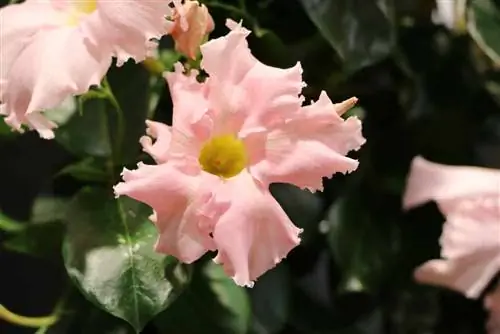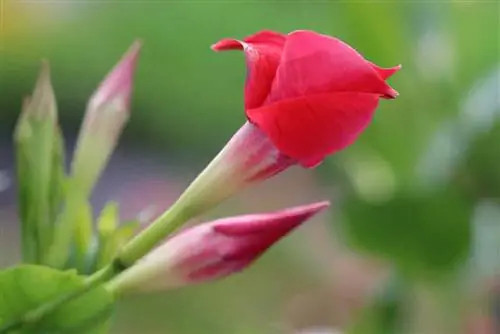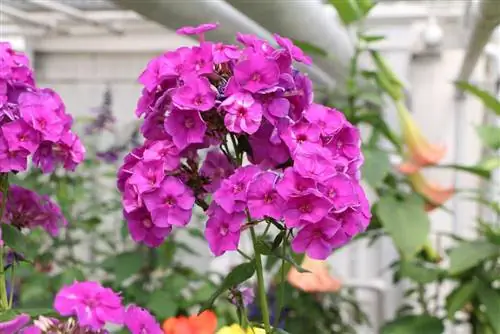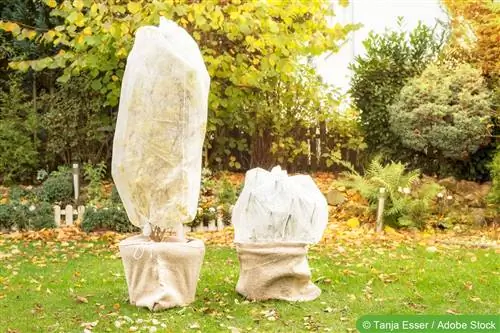- Author admin [email protected].
- Public 2023-12-17 03:39.
- Last modified 2025-06-01 06:48.
Since it is basically a climbing shrub and subshrub, the location should be carefully chosen. Depending on the variety, they grow hanging or upright, some varieties also lie down or climb. The typical characteristics of a Mandevilla are:
- The plants contain a white, poisonous latex.
- Thick roots store water for dry times.
- Their green leaves are rather thick and slightly hairy.
- It produces flowers of different sizes and colors.
The milky juice escaping can cause skin irritation. That's why it's very helpful to wear gloves when pruning. Above all, the beautiful flowers are what plant lovers appreciate about the Mandevilla. Depending on the version, they are available from white to bright pink and look similar to small trumpets. You can tell from the eye-catching flowers that the Mandevilla comes from the rainforest habitat, where it collects water in its calyxes. In addition, some variants of Mandevilla rank particularly strongly.
Location for the Mandevilla
The Mandevilla is a sun child because of its origins. It comes primarily from tropical areas in South America, Central America, Mexico and Argentina. With its special roots, some subspecies manage to store water in order to survive dry periods. This means that it can be placed on terraces and in winter gardens, where it can tolerate warm temperatures and direct sun. However, there should always be a slight breath of air so that the heat does not build up. For the same reason, it should not climb directly on the wall of the house or be placed against a window.
It is important that the Mandevilla gets air all around. However, to protect it from the blazing midday sun, it should be protected from it, especially in the hot months of summer. Maybe there is a parasol on the terrace or balcony anyway, then you can use it to protect the beautiful plant from burning. On the other hand, she doesn't like a place in full shade. Tip: Roots or soil area should be in the shade, use small plants here for protection.
In winter, the location for the plant should be bright and have temperatures between 18 °C and 5 °C. Depending on the variety, the temperature may be lower for a short time, for example with Mandevilla laxa around 8 °C with a tolerance of +/- 5 K.
Mandevilla Care
Just as you differentiate between summer and winter when it comes to locations, this should also be done when caring for the plant. In summer there is a high water requirement, which is due to the lush leaves and the relatively strong growth of the plant. However, the natural properties of the roots come into play here, as they can also store water and can therefore survive short-term thirst.
Tip:
In summer, water daily so that the soil is well moistened.
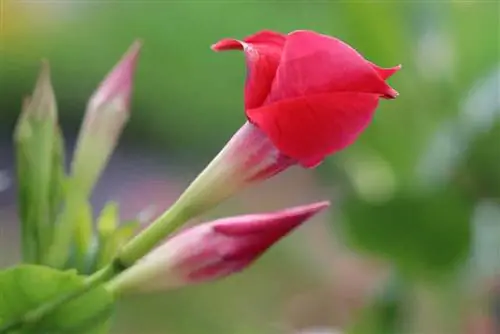
In winter, most plants have their own requirements and wishes. Since potted plants are then brought into the house, they need to receive special attention. The Mandevilla can also move into a cool winter quarters, but then the water consumption should be increased so as not to let the soil dry out. The plant does not tolerate cold feet, as can sometimes occur on stone soil. During this time it is not fertilized and only watered enough so that the potting soil does not dry out completely. During this phase, particular attention should be paid to possible pest infestation.
Tip:
Anchor the climbing aid in the pot, then moving to winter quarters is easier.
The Mandevilla shows its beautiful flowers well into autumn and some plant owners don't even want to think about the fact that the plant no longer wants to be outside. It certainly varies greatly depending on the location in the region as to when the first cool temperatures occur at night. As a precaution, however, it is better to bring the flower in earlier than to be surprised by a drop in temperature overnight. It is not hardy at all and therefore cannot tolerate short-term low temperatures.
Because the Mandevilla keeps putting out new flowers, it naturally also needs a lot of nutrients. However, the addition of pure water should not be excessive, as the moisture will then be invested in the growth of shoots and not in the formation of flowers. Nevertheless, it should not dry out or suffer from waterlogging. Good drainage in the pot is important. This can be made as usual by placing a pottery shard over the trigger hole.
Pruning and diseases
The Mandeville can easily be cut back if the shoots become too long and the plant becomes too large for its location. Like all other summer bloomers, it produces flowers on this year's shoots. For this reason, it is better if the plant is cut back before it sprouts. This is best done in the spring months of February and March. If you don't want the size to change, you should also cut back the Mandevilla's side shoots.
Tip:
Cut back to a maximum of 1/3 of the size.
The Mandevilla is propagated via a rooted cutting. You can also sow them, which you should use the time in spring for. All seedlings should be placed on warm soil. If the Mandevilla leaves turn yellow and fall off, it is usually a normal phenomenon of the plant's age. This happens more often, especially if the branches have not been cut back, because then the shoots age. Then the plant only flowers in the upper area. However, yellow leaves can also indicate a spider mite infestation. Then there are small webs (spider nests) under the leaves. In addition, the Mandevilla can be attacked by aphids. Both pests occur primarily in winter when the plants are in the winter garden or in the house on the windowsill.
What you should know in brief
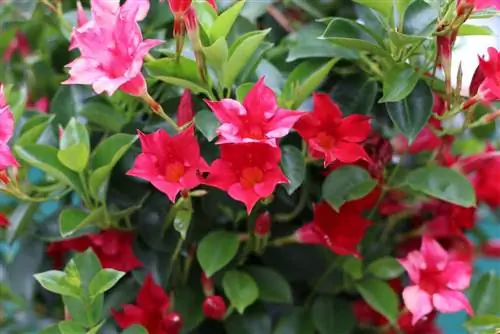
If you plan to decorate a terrace, balcony or winter garden with potted plants, you are more than well advised to use the Mandevilla. It blooms all summer long in the wonderful colors of white, rosé, red and yellow.
- The Mandevilla laxa is also known as Chilean jasmine. Its white flowers exude an intoxicating scent.
- Mandevillas are climbing plants and require climbing aid to thrive. If well cared for, they can grow up to 6 m tall.
- They will show their full blooms if you give them a place with full sunlight.
- To grow well, Mandevillas should be fertilized once a week. There is special high-quality pot plant fertilizer here.
- Mandevillas tolerate radical pruning very well and sprout again immediately in spring.
- Every cut causes injury to the plant. In Mandevilla, milky sap comes out of the fresh wound. This can be easily stopped by spraying the open area with water.
- Plants that are outside must be brought indoors before the first frost. A bright room with a temperature of 5 - 15 °C offers you a warm winter quarters.
- In April/May Mandevilla can be put out into the fresh air again.
This plant is also often attacked by aphids. From the beginning of May, you should check more often in order to be able to combat the spread of aphid infestation immediately. However, if the leaves are silvery speckled, this indicates an infestation of spider mites. Then immediately counteract it with appropriate sprays. Winding shoots should be guided to the climbing aids to prevent them from becoming entangled with neighboring plants and thus the spread of pest infestation.

